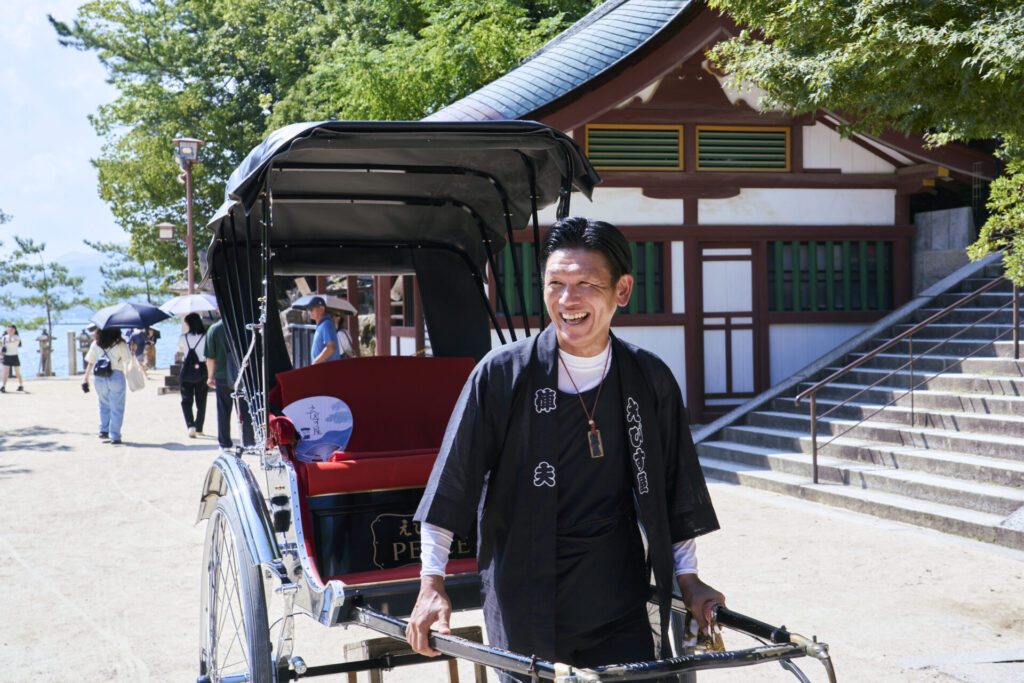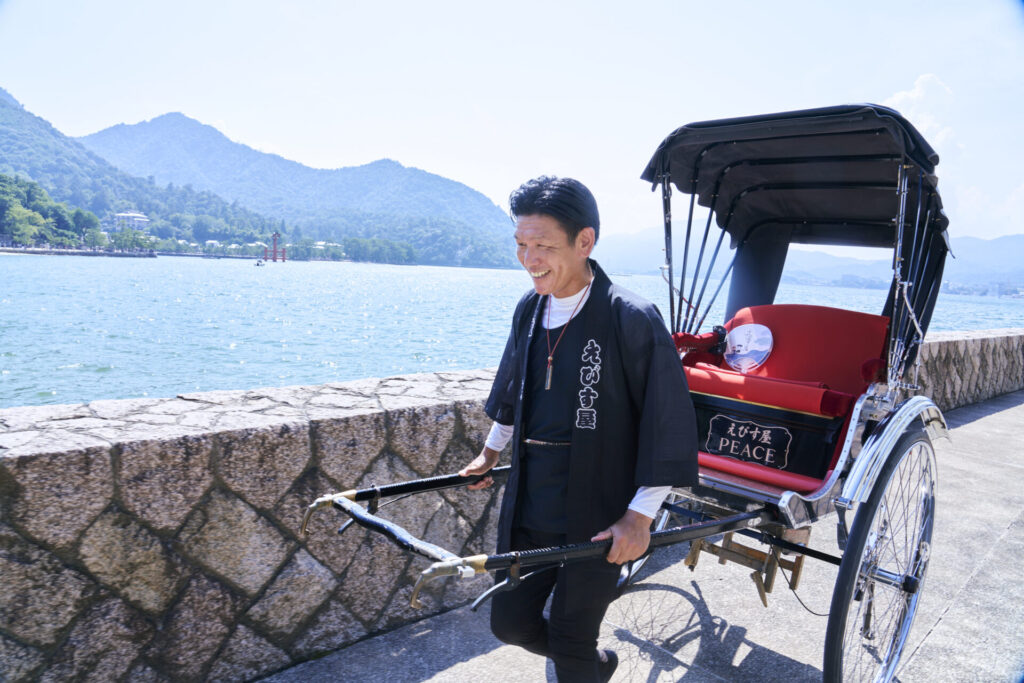
Sharing the Spirit of Miyajima through Rickshaws and Trekking — Hospitality that Connects People

北川 麻世
Mayo Kitagawa
Miyajima [Hiroshima]
Mayo Kitagawa
Born in Osaka Prefecture. President of Mayokatsu Ebisu Co., Ltd. While in university in Kyoto, he worked as a rickshaw driver in the scenic district of Arashiyama. After graduating, he moved to Tokyo to challenge herself in the world of comedy, but later returned to rickshaw guiding — eventually becoming the top-performing rickshaw driver in Japan. In 2011, he founded her own company on Miyajima, where he operates rickshaw services and, since the COVID-19 pandemic, has launched the Mount Misen Trekking Guide Tour. Kitagawa also trains young drivers and actively participates in local festivals and community events, contributing to Miyajima as both a guide and a community leader.
Born and raised in Osaka, Mayo Kitagawa has always been driven by a desire to make people smile. After pursuing dreams in music and comedy, he returned to the path he first discovered in university — the world of rickshaws. Having traveled across Japan’s tourist destinations, he established her own business on Miyajima in 2011. Since then, Kitagawa has continued to share the island’s charm as both a rickshaw driver and entrepreneur. Today, he expands her passion beyond rickshaws to include guided trekking tours of Mount Misen, offering visitors a deeper experience of Miyajima’s natural and spiritual beauty. We spoke with him about his journey and his hopes for the future he envisions alongside the island.
A Desire to Make People Smile — The Path to Becoming a Rickshaw Driver
“In Osaka, where I grew up, laughter is a part of everyday life,” says Mayo Kitagawa with a bright smile. “At my core, I just love making people happy.”

That spirit — the essence of Osaka’s warm humor and liveliness — has always shaped who he is. “I can’t say I’m particularly good at talking,” he laughs, “but I definitely don’t dislike it.” His natural charisma and easy conversation have captivated countless visitors.
During her university years in Kyoto, Kitagawa longed to express his individuality by doing something different. That’s when he discovered the world of rickshaw guiding — a part-time job that would change his life.
“I was shocked that such a job even existed! If I could make people smile through this, I had to try it,” he recalls. “My first workplace was in Arashiyama, one of Japan’s most famous sightseeing areas, and I immediately fell in love with it. Looking back, those days were truly fulfilling.”
His passion for bringing joy to others led him to explore various paths — music, comedy, and even competing in Tokyo’s M-1 Grand Prix, Japan’s top comedy contest. But he soon faced the reality of how tough the entertainment industry could be.
“I realized how difficult that world was,” he says. “Thinking about my future five or ten years ahead, I started to doubt whether I could stay motivated. Then I remembered the rickshaw work I had been so passionate about in college. I decided to give it another try — and this time, aim to become the best.”
His determination quickly bore fruit. Among roughly 300 rickshaw drivers nationwide, Kitagawa rose to the number one position in sales, earning recognition and even encouragement from her company to go independent.“What I focused on most was improving the quality of hospitality,” he explains. “When I guided passengers, I not only introduced the local sights but also wanted them to feel the unique value of being taken around by a person — that human warmth. I think that’s what led to the results.”
Sharing the Spirit of Hospitality — The Unique Appeal of Miyajima
After being encouraged to go independent, Kitagawa spent about three years traveling across Japan’s major sightseeing destinations as a rickshaw driver. From Asakusa and Kamakura to Otaru and Yufuin, she pulled her rickshaw through many streets, meeting countless travelers and discovering the depth and joy of the profession. Yet, he couldn’t decide where to settle down and start her own business.

“Actually, the first place I ever visited during that journey was Miyajima,” he recalls. “
At the time, another company was already operating here, so I ruled it out as a candidate. But the impression the island left on me stayed in my heart. When I returned three years later, that feeling came rushing back — and I knew this was the place.
”What convinced him was how much diversity and charm Miyajima holds within such a compact area. Rickshaws cannot travel long distances like cars, so having numerous cultural, historical, and natural attractions clustered close together was a major advantage.

“The calm atmosphere of the Seto Inland Sea also fits perfectly with the rickshaw,” he says. “I love the sea myself, and being able to share its beauty while guiding along the coast is something truly special about Miyajima.”
Once he began operating on the island, he grew to appreciate its depth even more — while also recognizing new challenges.
“Most visitors just follow the standard route: visit Itsukushima Shrine, eat momiji manju (maple-leaf cakes), and leave. But I realized Miyajima offers so much more,” Kitagawa explains.
He began guiding guests to lesser-known sites such as Mount Misen, the sacred mountain regarded as a deity; Daishoin Temple, founded by the monk Kukai; and Momijidani Park, glowing red with autumn leaves.
“There are countless wonderful places here,” she says. “By showing people those hidden spots, I felt I could expand what a rickshaw experience could be.”

When taking guests off the beaten path, Kitagawa makes a point of guiding carefully and personally — sometimes stopping the rickshaw to walk alongside visitors or taking photos for them at scenic spots. Those are the moments when travelers realize that a rickshaw ride is more than transportation — it’s a shared experience.
Because of that closeness, what he says and how he makes guests feel matter deeply. His hospitality, rather than the service itself, is the heart of his craft.
Alongside her work, Kitagawa also began focusing on training younger drivers. Each rickshaw driver’s interaction style and personality create their own brand of hospitality. He encourages them to find and express their individuality while learning from his experience.
“In a way, rickshaw driving is a job where you sell yourself,” he says. “The satisfaction of the customer depends on the quality of that interaction — and seeing them happy makes all the effort worthwhile. Every encounter is like a small drama, and no two are ever the same.”
At the root of it all is Kitagawa’s own affection for Miyajima — its ever-changing sea, the shrine glowing under the morning and evening light, and the cherry blossoms and maple leaves that color the island through the seasons.
“I want people to visit not just once, but again and again,” he says.Now in his fourteenth year on Miyajima, the island continues to inspire him every day.
Revealing a New Side of Miyajima — The Mount Misen Trekking Tour
When tourism came to a halt during the COVID-19 pandemic, Kitagawa didn’t stop moving. Instead, he launched a new challenge: the Mount Misen Trekking Guide Tour.

“There are aspects of Miyajima’s beauty that can’t be conveyed through rickshaw rides alone,” he explains. “I wanted to share those with visitors.
”Mount Misen, where the monk Kukai (Kobo Daishi) once trained, remains a sacred mountain filled with traces of Japan’s ancient syncretism of Shinto and Buddhism. The tour, which takes about ninety minutes, invites participants to explore key spiritual sites — the Sanki-do Hall, where three demons are worshipped as gods; the summit of Mount Misen at 535 meters, offering sweeping views of the Seto Inland Sea; and the Reikado Hall, where the sacred flame lit by Kukai more than 1,200 years ago still burns today.
The experience allows travelers to feel the island’s deep spiritual roots through its landscapes, legends, and culture. On private courses, guests can visit even more secluded spots for a deeper, more personal journey.

“My favorite view is from Sanki-do Hall,” says Kitagawa. “The summit panorama is amazing, but sitting on the wooden veranda of the hall and looking down at the sea feels as if you’re floating above the Seto Inland Sea. What’s fascinating is that here, demons are worshipped as gods, and visitors bow in the Shinto style — two bows, two claps, one bow — even though it’s a temple. It’s a living example of the unique syncretic faith that still thrives on Miyajima.”
As a guide, Kitagawa pays close attention to each participant — their pace, their interests, their mood — and tailors her explanations accordingly. Some come seeking the island’s spiritual energy, while others simply wish to enjoy hiking and nature.
“It’s about reading what people are looking for,” he says. “I always try to adapt my stories and routes so everyone can have their own kind of experience.”
His tours are also known for their memorable photography service.
“People often get too focused on walking to take good pictures,” he explains with a laugh. “That’s where we, the guides, step in. We train our bodies daily, so we can move like ninjas — capturing shots from surprising angles that delight our guests.”
Even after years of walking the island’s trails, Kitagawa says the view from Misen never fails to move her. The crisp air, the gentle wind, and the vast expanse of the Seto Inland Sea remind her of Miyajima’s timeless beauty.“Even in today’s fast-changing world,” he says, “the calm of the Seto Inland Sea, the quiet dignity of Itsukushima Shrine, and the island’s natural grandeur all make you feel the unbroken flow of history. That’s why I believe Miyajima is a place worth visiting — especially when life feels busy.”
What Do You Wish to Pass On to the Future?
When asked what he hopes to carry forward into the future, Kitagawa answers without hesitation.

“I truly believe that customer satisfaction is supported by the spirit of hospitality each rickshaw driver holds,” he says. “The longer you continue, the more depth your service gains, and the more meaningful your interactions become. As I’ve said before, rickshaw driving is a job where you sell yourself. Each driver’s warmth and sincerity create stronger connections with the people they meet.”
Kitagawa hopes more people will come to appreciate the true charm of rickshaw culture — not just in Kyoto or Asakusa, but also on Miyajima, where the experience takes on a character all its own.
“If more visitors discover the unique appeal of Miyajima’s rickshaw rides, it will encourage the growth of young drivers and contribute to the island as a whole. That’s why I want to keep refining our hospitality and supporting the next generation of shafu.”
When he first went independent, Kitagawa was seen as an outsider. But with his bright personality and genuine desire to contribute to the community, he gradually built trust and closeness with local residents. As Miyajima faces an aging population, he actively joins local festivals and events, taking on a leading role in sustaining the island’s traditions. Today, he says proudly:
“I finally feel that I’ve become a true member of the Miyajima community.”
Smiling, he adds:
“I don’t know much about spiritual matters, but perhaps being able to run my business here for so long means the gods of Miyajima have accepted me. If I can keep doing this twenty or thirty years from now, it must mean they don’t dislike me too much.”Amid the tranquil sea and mountains of the Seto Inland Sea, Kitagawa continues to weave new connections between people — one ride, one step, and one smile at a time. His cheerful energy and heartfelt hospitality will no doubt keep drawing travelers to Miyajima for many years to come.
